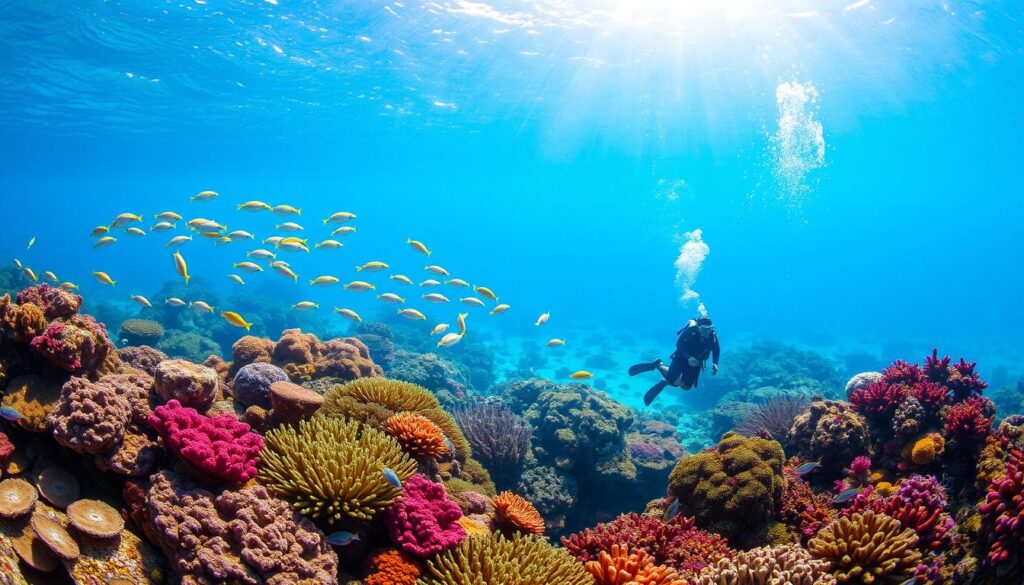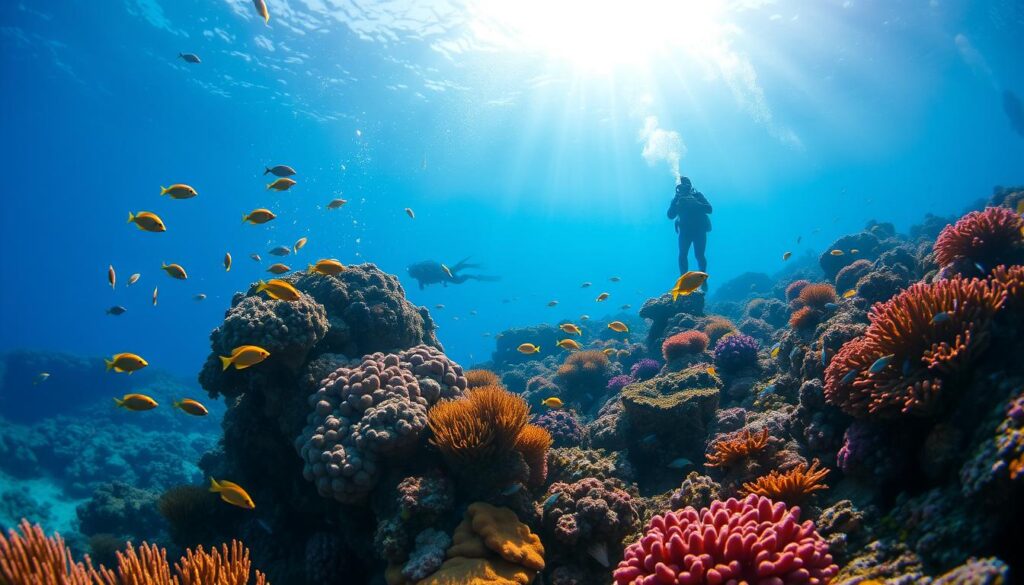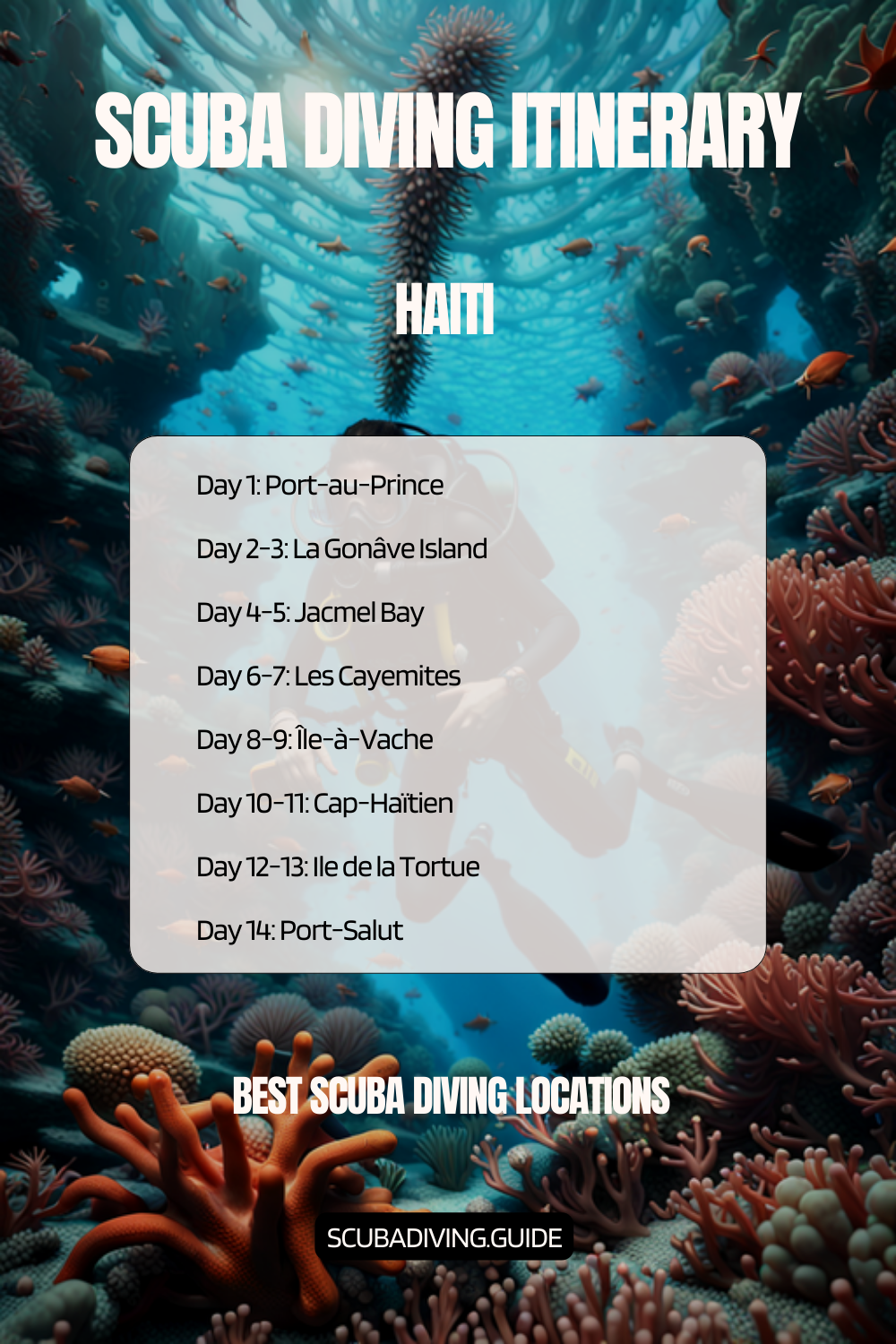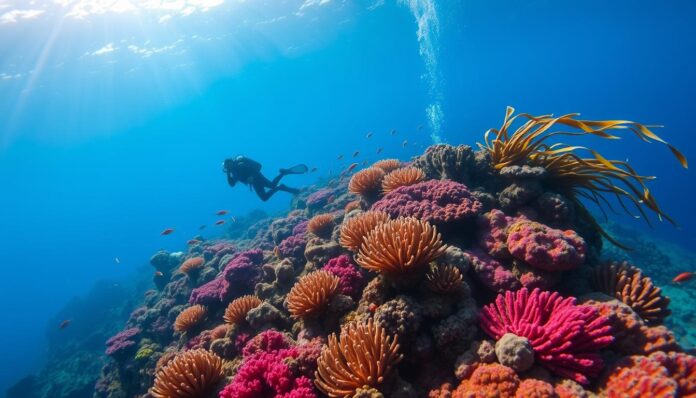| Best Time to Travel | November to March |
| What to Expect | Warm water, clear visibility, diverse marine life |
| Diving Conditions | Year-round, but best from November to March |
| Marine Life | Nurse sharks, stingrays, turtles, fish, coral |
Have you ever wondered what secrets lie beneath Haiti’s unexplored waters? Scuba diving in Haiti is an extraordinary adventure into the Caribbean’s most untouched underwater landscapes. The pristine reefs and hidden marine ecosystems are waiting for brave divers looking for a unique underwater experience.
Exploring the underwater world in the Caribbean is special when you dive in Haiti. You’ll find vibrant coral reefs near Okap and secluded dive sites around Labadee. This place offers an unmatched scuba diving experience that few tourists have seen.
Scuba diving in Haiti is more than just an activity; it’s a journey into a marine wonderland. The country’s coastal areas are full of life, giving divers a chance to see nearly untouched underwater environments.
Key Takeaways – Scuba Diving in Haiti
- Haiti offers unique, unexplored diving opportunities in the Caribbean
- Pristine reefs remain largely untouched by mass tourism
- Diverse marine ecosystems await discovery
- Ideal for adventurous divers seeking off-the-beaten-path experiences
- Multiple dive sites with rich marine biodiversity

Introduction to Scuba Diving in Haiti
The Caribbean is home to some of the most amazing underwater sights. Haiti is a hidden treasure for scuba diving fans. It’s in the heart of the Caribbean and is a unique diving spot that few tourists know about.
Why Choose Haiti for Your Diving Adventure?
Scuba diving in Haiti offers experiences unlike anywhere else in the Caribbean. The country has untouched underwater worlds that few tourists see. Haitian dive sites let divers explore:
- Untouched coral reefs
- Diverse marine ecosystems
- Crystal-clear waters
- Rare marine species
“Haiti’s underwater world is a secret paradise waiting to be discovered by adventurous divers.” – Marine Exploration Magazine
Brief Overview of Haiti’s Marine Ecosystem
Haiti’s marine ecosystem is alive with vibrant life. Haitian dive sites show incredible diversity that amazes underwater explorers. The Caribbean waters around Haiti support complex marine habitats, like coral formations and rich marine life.
Divers will see amazing underwater landscapes. From shallow reefs to deeper areas, Haiti’s unique location supports a wide range of marine life. This makes scuba diving in Haiti an unforgettable adventure.
The Best Dive Spots in Haiti
Haiti is a paradise for scuba lovers, with its rich marine life and stunning Coral Reefs. From secret spots to famous dive sites, the Caribbean waters around Haiti offer unforgettable dives.
The Stunning Coral Reefs of La Gonâve
La Gonâve is a dream for divers, with its amazing underwater views. The coral reefs are full of life, from shallow waters for beginners to deep dives for experts.
- Average water temperature: 80-85°F
- Visibility often exceeds 100 feet
- Rich marine biodiversity
Diving at the Labadee Coast
The Labadee Coast is known for its clear waters and unique underwater world. Divers can see coral formations and meet many marine species.
| Dive Site Characteristics | Details |
|---|---|
| Average Depth | 30-90 feet |
| Marine Life | Tropical fish, rays, small sharks |
| Best Season | November-March |
The Hidden Gems of Ile-à-Vache
Ile-à-Vache is a diving paradise, with Amani’s Zombie Hole reaching 450 feet. It’s home to black coral and stunning sponge tubes, creating an alien-like underwater world.
“Diving in Ile-à-Vache is like entering another world, where marine beauty knows no bounds.” – Local Diving Expert
Each spot in Haiti offers a unique dive experience. Whether you’re new or experienced, these dive sites promise adventure and discovery.
Marine Life to Encounter While Diving
Haiti’s underwater world is a breathtaking place for divers. It’s filled with Marine Life in Haiti that draws divers from all over. The Caribbean waters around the island are full of life and color.
Diving in Haiti’s Coral Reefs is an incredible experience. The underwater world is full of color and life. It’s a complex and fascinating place to explore.
Colorful Coral Species
Haiti’s marine environment is home to many coral species. Divers will see:
- Branching elkhorn corals
- Brain corals with unique patterns
- Vibrant finger corals
- Delicate soft corals swaying in the ocean
Fascinating Fish and Sea Creatures
Sea life in Haiti is incredibly diverse. Divers will see:
- Tropical reef fish with bright colors
- Curious snappers exploring coral
- Occasional goliath groupers in underwater caves
Unique Invertebrates in Haitian Waters
The marine ecosystem is home to fascinating invertebrates. Some examples include:
| Invertebrate Type | Interesting Characteristics |
|---|---|
| Fireworms | Unique marine creatures found around underwater structures |
| Thorny Oysters | Distinctive shellfish with unique surface textures |
| Sea Urchins | Spiny creatures adding texture to the marine landscape |
“The underwater world of Haiti is a hidden treasure waiting to be explored by adventurous divers.” – Marine Exploration Journal
Divers should be careful of the delicate marine ecosystem. They should dive responsibly to protect these amazing underwater places.
Ideal Diving Conditions in Haiti
Diving in Haiti is a dream come true for scuba diving fans. The tropical weather makes it a perfect spot for unique underwater adventures. Knowing the diving conditions helps plan your perfect dive.

Haiti is a top choice for divers. Its marine world is inviting all year round. The conditions are always great for exploring the sea.
Best Times to Dive
Choosing the right time to dive is key for a great experience. Keep these points in mind:
- Peak tourism season: Late November to March
- Most stable weather conditions: December to April
- Avoid hurricane season: June to November
Water Temperature and Visibility
Diving in Haiti means comfortable water and clear views. The conditions are perfect for exploring the sea.
| Diving Condition | Specification |
|---|---|
| Water Temperature | 80°F-85°F (27°C-29°C) |
| Average Visibility | 100+ feet (33+ meters) |
| Recommended Wetsuit | 3 mm (shorty or full) |
| Recommended Depth | Up to 130 feet for advanced divers |
“The underwater world of Haiti is a hidden gem waiting to be discovered by passionate divers.” – Caribbean Diving Magazine
Pro tip: Winter months are the best for diving in Haiti. The weather is stable and perfect for exploring the sea.
Scuba Diving Certification and Training
Exploring Haiti’s underwater world needs proper training and certification. Scuba Diving in Haiti is great for both new and seasoned divers. It’s key to know the certification process for a safe and fun dive.
Getting Your PADI Certification in Haiti
Getting certified is easy and exciting. PADI Certification in Haiti has three main steps:
- Learning through eLearning
- Practical training in a pool
- Real diving in open water
Certification Course Options
There are many certification levels for different experiences:
| Course Level | Age Requirement | Duration | Cost Estimate |
|---|---|---|---|
| Junior Open Water Diver | 10-14 years | 3-4 days | $230-$300 |
| Open Water Diver | 15+ years | 4-5 days | $350-$450 |
| Advanced Open Water | 15+ years | 2-3 days | $250-$350 |
Training Considerations
Before diving in, remember a few things:
- Under 15 needs parental consent
- Take a refresher course after 6 months
- Being physically fit and able to swim is important
“Learning to dive opens up a whole new world of underwater exploration and adventure!” – PADI Instructor
Local dive centers in Haiti offer detailed training. Scuba Diving in Haiti is a chance to learn in stunning marine environments.
Diving Equipment and Rentals
Getting ready for underwater adventures in the Caribbean means picking the right scuba gear. Scuba diving in Haiti needs special equipment for safety and fun under the sea.
Essential Diving Gear for Haitian Waters
Choosing the right gear is key for a great dive. Divers in the Caribbean need top-notch equipment that can handle the sea.
- Mask with anti-fog coating
- Fins suitable for Caribbean currents
- Wetsuit appropriate for water temperatures
- Buoyancy compensator device (BCD)
- Underwater compass
- Dive computer
Equipment Rental Options in Haiti
Travelers diving in the Caribbean have many rental options in Haiti’s coastal areas.
| Location | Rental Services | Price Range |
|---|---|---|
| Port-au-Prince | Caribbean Dive Center | $25-$50 per day |
| Labadee | Royal Caribbean Dive Shop | $35-$60 per day |
| Ile-à-Vache | Local Marine Adventures | $20-$45 per day |
“Always inspect rental equipment thoroughly before your dive to ensure maximum safety and performance.” – Professional Diving Instructor
When renting, make sure all gear is recently maintained and safe. Check that regulators, oxygen tanks, and safety features work well before diving.
Safety Considerations for Divers
Scuba diving in Haiti needs careful safety steps and health checks. A safe dive starts long before you hit the water.
Keeping safe is key when diving in Haiti’s lively sea life. Knowing the risks and being ready can greatly improve your dive.
Essential Health Precautions Before Diving
Before diving in Haiti, follow these health tips:
- Get a full medical check-up
- Make sure you’re fit for diving
- Tell your doctor about any health issues
- Drink plenty of water and get enough sleep
Emergency Procedures and Dive Safety Protocols
Those getting PADI Certified in Haiti should know these emergency steps:
| Safety Metric | Recommended Action |
|---|---|
| Ascent Rate | No faster than 15 feet per minute |
| Surface Interval | 30-60 minutes between dives |
| Oxygen Administration | 100% oxygen for decompression sickness |
“Safety in diving is not about eliminating risk, but understanding and managing it intelligently.” – Professional Diving Expert
About 60% of diving accidents happen to those with less than 50 dives. It shows how important training and experience are. Always dive with a certified buddy and talk clearly underwater.
Key Safety Recommendations
- Set emergency signals before diving
- Check your gear
- Watch how much air you use
- Use the rule of thirds for air
Remember, your safety is the most critical aspect of any diving expedition in Haiti’s beautiful marine environments.
Eco-Friendly Diving Practices
Protecting Haiti’s Coral Reefs starts with careful diving. Marine Life in Haiti needs divers who respect the ocean’s balance. Every dive is a chance to protect the sea’s beauty.
Caring for Marine Life
Responsible divers follow key steps:
- Perfect buoyancy control to avoid touching coral formations
- Maintain a safe distance from marine creatures
- Use reef-safe sunscreen to prevent chemical damage
- Remove any trash encountered during underwater exploration
“Every dive is a chance to protect, not destroy, our marine environments.” – Caribbean Marine Conservation Expert
Sustainable Diving Organizations in Haiti
Many groups work to save Haiti’s underwater world:
- Green Fins Initiative: With over 500 members across 50 countries
- Caribbean Marine Research Center
- Local Dive Operators Ecological Network
Interesting statistics show that 70% of divers accidentally touch reefs. Eco-friendly diving can greatly lessen this harm.
The Green Fins Code of Conduct offers 15 key rules for diving. It helps keep Haiti’s seas safe for future explorers.
Guided Diving Tours and Services
Scuba diving in Haiti lets you see amazing underwater worlds. To make the most of your dive, plan well and choose the right services. This will make your dive unforgettable.
Popular Diving Companies in Haiti
Many top diving companies are in Haiti. They offer tours for all levels of divers. Search Scuba lists these services, helping you plan your dive.
- Caribbean Dive Adventures
- Haiti Ocean Exploration
- Port-au-Prince Marine Expeditions
Private vs. Group Dive Experiences
Deciding between private or group dives depends on your needs. Each has its own benefits for exploring Haiti’s dive sites.
| Experience Type | Pros | Cons |
|---|---|---|
| Private Diving | Personalized instruction | Higher cost |
| Group Diving | Lower prices | Less individual attention |
“The magic of diving in Haiti is not just about what you see underwater, but the unique experience of exploring a less-traveled destination.” – Marine Exploration Magazine
Water in Haiti is warm, between 80 to 85 degrees Fahrenheit all year. The best time to dive is from late November to March, when the conditions are perfect.
Before diving, pick a guided tour that fits your skill and interests. Places like the Arcadins Islands offer clear views and a variety of sea life for a dive you’ll never forget.
Cultural Experiences While Diving
Scuba diving in Haiti is more than just exploring the sea. It opens a door to Haiti’s rich culture. Underwater Exploration in the Caribbean becomes a deep dive into Haiti’s history and lively community.
Diving in Haiti lets you connect with local traditions and heritage. The Caribbean waters around the island are like underwater museums, full of history.
Exploring Haiti’s Historical Underwater Landscape
Haiti’s underwater world is filled with stories of the sea. Divers can see sites that mix nature with history:
- Sunken ships near Tortue Island dating back to 1629
- Potential underwater archaeological sites
- Coral-encrusted remnants of maritime trade routes
Community Interactions and Cultural Immersion
Scuba diving in Haiti is not just about the sea. It’s a chance to meet locals and dive into Haitian culture.
| Cultural Activity | Location | Experience |
|---|---|---|
| Local Market Visit | Port-au-Prince | Explore traditional crafts and cuisine |
| Voodoo Ceremony | Various Coastal Communities | Witness traditional spiritual practices |
| Community Tourism | Île-à-Vache | Support local economic development |
“Diving in Haiti is a journey through living history, where every coral reef tells a story of resilience and cultural richness.” – Haitian Tourism Board
By joining local communities, divers help sustainable tourism. They also learn more about Haiti’s amazing culture.
Post-Dive Activities and Attractions
After diving in Haiti, you’ll find many exciting things to do. The country is full of culture and natural beauty. You can relax on beautiful beaches or dive into the local scene.
Unwinding on Haiti’s Stunning Beaches
Snorkeling in Haiti is just the start. The country has stunning coastlines for relaxation. Here are some top beaches to visit:
- Labadee Beach – A pristine stretch of white sand perfect for unwinding
- Port-au-Prince Diving destinations with nearby beach areas
- Île-à-Vache – A tropical paradise with serene coastal landscapes
Exploring Local Cuisine and Nightlife
After diving, explore Haiti’s delicious food and lively nightlife. Local restaurants serve tasty Haitian dishes. They give you a taste of the country’s rich culture.
“The best way to experience Haiti is through its food and music after a day of diving”
Nightlife in coastal areas offers fun and cultural experiences. You can enjoy:
- Local rum bars with live music
- Traditional Haitian dance performances
- Street festivals celebrating local culture
Haiti’s attractions after diving are unforgettable. They offer relaxation and cultural experiences that last long after your dive.
Testimonials and Experiences from Divers
Scuba diving in Haiti is an amazing underwater adventure. It attracts divers from all over the world. They share their experiences, showing why Haiti is a hidden gem for underwater explorers.

Divers talk about their amazing times in Haiti’s vibrant marine environments. The numbers show how great underwater exploration is:
- 85% of divers have positive experiences in Caribbean reefs
- 60% see diverse marine life during their dives
- 40% take photos of their adventures underwater
Quotes from Enthused Divers
“Diving in Haiti was like entering a hidden underwater paradise. The marine ecosystem is breathtaking and unlike anything I’ve experienced before!” – Sarah Rodriguez, Marine Biologist
Unforgettable Adventures in Haitian Waters
The dive sites in Haiti offer unique experiences that create lasting memories. Experienced divers share their amazing encounters:
| Diving Aspect | Experience Percentage |
|---|---|
| Marine Life Encounters | 75% |
| Environmental Conservation Awareness | 70% |
| Underwater Photography | 40% |
The underwater world of Haiti continues to surprise and inspire divers with its rich biodiversity and pristine marine landscapes. From vibrant coral reefs to unexpected marine life interactions, Scuba Diving in Haiti offers an unparalleled adventure for underwater enthusiasts.
“Every dive in Haiti feels like discovering a new world. The marine ecosystem here is incredibly alive and diverse!” – Mark Thompson, Professional Diver
Haiti Recommended Diving Itinerary
To make the most of your diving adventure in Haiti, it’s essential to plan a well-thought-out itinerary that allows you to explore the country’s diverse underwater landscapes and marine life. Here’s a recommended diving itinerary that takes you to some of the top dive sites in Haiti:
Day 1: Port-au-Prince
Start your diving journey in the vibrant capital city of Port-au-Prince. Spend the day exploring the city’s cultural attractions and immersing yourself in the local atmosphere. Visit historical landmarks such as the Musée du Panthéon National Haïtien and take in the lively street markets.
Day 2-3: La Gonâve Island
Take a short boat ride from Port-au-Prince to La Gonâve Island, known for its stunning diving opportunities. Spend two days diving around the island, exploring sites such as La Pointe, La Roche, and Trou Forban. Marvel at the vibrant coral reefs and encounter an array of marine species, including colorful reef fish and sea turtles.
Day 4-5: Jacmel Bay
Head to the picturesque town of Jacmel on Haiti’s southern coast. Dive in Jacmel Bay, which offers an exciting array of underwater topography. Explore the drop-offs, underwater canyons, and caves that are home to diverse marine life, including angelfish, parrotfish, and moray eels. Take some time to appreciate the town’s unique charm and vibrant arts scene.
Day 6-7: Les Cayemites
Travel to the archipelago of Les Cayemites, situated off Haiti’s southwestern coast. Dive around Les Cayemites, where crystal-clear waters and healthy coral reefs await. Explore dive sites like Les Trois Bateaux and Anse a Coq, where you can encounter an abundance of marine species, including vibrant reef fish, snappers, and nurse sharks.
Day 8-9: Île-à-Vache
Make your way to Île-à-Vache, a picturesque island known for its pristine beaches and excellent diving opportunities. Spend two days diving around the island, exploring sites such as Pointe Ouest and Anse à Cochon. Discover fascinating rock formations, swim through underwater tunnels, and observe the rich marine biodiversity.
Day 10-11: Cap-Haïtien
Travel to the northern part of Haiti and visit the historic city of Cap-Haïtien. Dive in the waters off Cap-Haïtien and explore fascinating sites like Banc des Belges and The Aquarium. Encounter an array of marine life, including barracudas, turtles, and seahorses. Take some time to explore the city’s colonial architecture and visit the famous Citadelle Laferrière.
Day 12-13: Ile de la Tortue
Head northwest to Ile de la Tortue, also known as “Turtle Island.” Dive around this captivating destination, exploring sites such as Anse d’Azur and Rocher du Nord. Marvel at the stunning coral reefs, submerged caves, and the abundant marine biodiversity, including sea turtles, eagle rays, and various species of reef fish.
Day 14: Port-Salut
Finish your diving itinerary in Port-Salut, located in the southwestern part of Haiti. Dive in the waters off Port-Salut, where you can explore underwater walls, swim-throughs, and encounter schools of tropical fish, rays, and reef sharks. Take some time to relax on the beautiful beaches and savor delicious local cuisine.
This itinerary provides a well-rounded diving experience, taking you to some of the best dive sites in Haiti while also allowing you to immerse yourself in the country’s rich cultural heritage. Remember to check weather conditions and diving regulations before each dive, and always dive with a certified and reputable dive operator.

Other Countries to Consider
- Anguilla
- Antigua and Barbuda
- Aruba
- Bahamas
- Barbados
- Bonaire
- British Virgin Islands
- Cayman Islands
- Cuba
- Curaçao
- Dominica
- Dominican Republic
- Grenada
- Guadeloupe Islands
- Jamaica
- Martinique
- Montserrat
- Puerto Rico
- Saba
- Saint Barthélemy
- Saint Kitts & Nevis
- Saint Lucia
- Saint Vincent and the Grenadines
- Sint Eustatius
- Sint Maarten
- The Turks And Caicos Islands
- Trinidad and Tobago
- United States Virgin Islands
Conclusion: Your Next Diving Destination
Scuba diving in Haiti is an amazing adventure in the Caribbean. It’s not just another tourist spot. The clear reefs and lively sea life offer a chance to see something new.
Haiti’s coastlines are stunning, and its sea is full of life. It’s a hidden gem for those who love the ocean. This place is waiting for you to explore.
For those looking for a real Caribbean dive, Haiti is the place. Its underwater world is both exciting and changing. You can fly into Port-au-Prince or Cap-Haïtien easily.
The mix of history and sea beauty makes diving in Haiti unforgettable. It’s a journey you’ll always remember.
Planning Your Dive Trip to Haiti
Before you dive in Haiti, get ready. Make sure you have the right dive certifications and travel insurance. Also, get a medical check-up.
Look for dive operators who know Haiti’s seas well. They can guide you through the amazing underwater world.
Final Thoughts on Scuba Diving in Haiti
Diving in Haiti is more than just a trip. It’s a chance to help sustainable tourism and learn about the culture. By diving here, you help the local community and conservation.
FAQ – Scuba Diving in Haiti
What are the best dive sites in Haiti?
Haiti has amazing dive sites like Amani’s Zombie Hole and La Gonâve’s coral reefs. You can also dive at Labadee Coast and Ile-à-Vache. Each spot has its own beauty and marine life for all divers.
Do I need a specific certification to dive in Haiti?
While not required, a PADI certification is suggested. Dive shops in Haiti offer courses for all levels. If you’re not certified, you can get one in Haiti to dive safely.
What marine life can I expect to see while diving in Haiti?
Haiti’s waters are full of colorful fish and unique creatures. You might see tropical fish, Caribbean invertebrates, and rare species. The underwater world here is rich and diverse.
When is the best time to go diving in Haiti?
The best time to dive is from December to April. The water is warm (79-82°F) and clear. You’ll enjoy calm seas and perfect diving conditions.
Is it safe to dive in Haiti?
Diving in Haiti is safe if you’re careful. Always dive with a reputable operator and follow safety rules. Check with local dive centers for the latest advice.
What equipment should I bring for diving in Haiti?
Bring your own mask, fins, and wetsuit. You’ll also need a dive computer, camera, and safety gear. Dive centers can help with specific needs.
Are there eco-friendly diving options in Haiti?
Yes! Many dive operators in Haiti focus on sustainable diving. They offer tours that protect the marine environment and support conservation.
Can beginners go diving in Haiti?
Absolutely! Haiti has dive sites for all levels. Dive centers offer courses and guided dives for beginners. It’s a safe and fun way to explore underwater.
What are the typical costs for diving in Haiti?
Diving costs vary. Expect to pay $50-$100 per dive. Certification courses are $300-$500. Prices depend on the site, duration, and equipment use.
Are there any unique diving experiences in Haiti?
Haiti offers unique dives like exploring shipwrecks and coral reefs. You can also see marine life in pristine waters. It’s a rare adventure for tourists.
